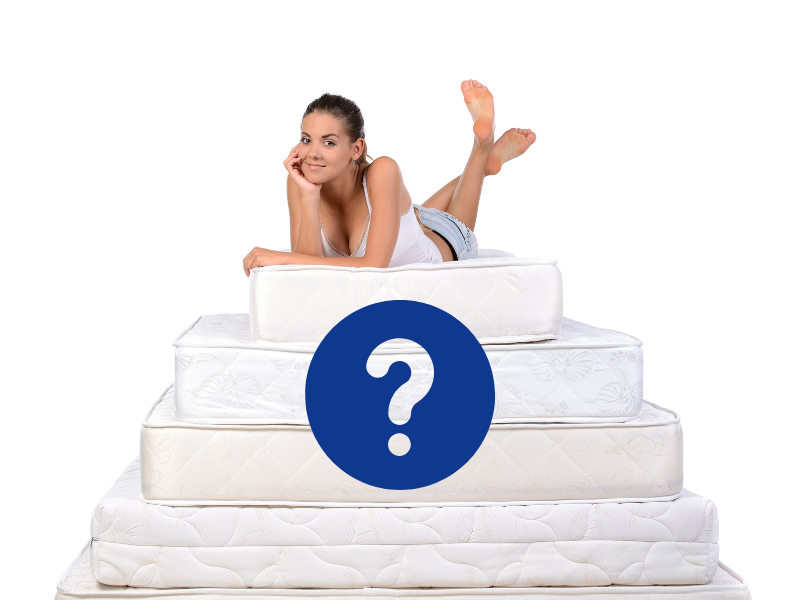Getting restful, high-quality sleep should be second nature.
After all, we spend one-third of our lives sleeping (or worse, trying to sleep!). Tossing and turning for hours during the night is no way to spend decades of your life.
There are countless methods for better sleep that have circulated around the internet and within social circles.
From ‘sleepytime mocktails’ filled with magnesium and tart cherry juice to mouth taping, there is no shortage of remedies to try and soothe people to sleep.
However, sometimes the solution to sleep can be found by looking at the source of the problem: your mattress!
Although mattresses often fly under the radar for causing sleep disturbances, they can be the primary culprit. So, in this article, we’ll discuss how often people should change their old mattress for a new one!
If you’ve had your mattress for a while, stick around to learn about how often you should change your mattress, the importance of mattress replacement, and tips for prolonging your mattress’s life.
Let’s begin!
How Often Should You Change Your Mattress?
According to the Better Sleep Council, you should aim to change your mattress every 7 years.
However, this number depends on other factors, such as how your mattress is treated, the use of a mattress pad/protector, and its material.
If you’re unsure of your mattress’s overall wear and tear, check out the next section as we’ll discuss the signs to watch out for!
The Signs of Mattress Wear and Tear
As one of the most used and longest-lasting items in a home, mattresses tell a detailed story.
As your sleeping needs change, so does your mattress – which is why knowing the signs of mattress wear and tear is very important! This way, you may be able to avoid countless sleepless nights by solving the issue before it becomes too severe.
Sagging or indentations
Sagging or indentations can occur due to mattress material breaking down, which is almost always a result of age.
Additionally, mattresses that are lower quality are more likely to sag than their higher-quality counterparts.
Finally, sleeping in the same spot every night can cause an indentation from repeated pressure on the same area.
Lumps or bumps
Lumps and bumps are usually the opposing action of a mattress when indentations are made.
Mattress peaks and valleys are common with people who sleep in the same spot every night. Lumps and bumps can make it difficult to move, which may disrupt your sleep.
Decreased support
The support offered by a mattress is one of the first aspects to deteriorate when a mattress has reached the end of its life.
If you find yourself waking up with a sore back or shoulders, it could be the result of decreased support for your mattress.
Visible wear on fabric or seams
Although many signs of mattress wear are invisible, visible signs of wear on fabric or seams are a clear indication that your mattress may be on its last leg.
If there is clear evidence of fraying, straining, or seam distress, it may be time to think about investing in a new mattress.
Allergen buildup
Allergens can build up in the crevices of a mattress, which can subsequently make it difficult to sleep on.
If you’re prone to allergies – especially from dust and pollen – exposure to these allergens over time can disrupt healthy sleeping patterns. Mattresses are notorious for hoarding dust, so make sure to vacuum regularly!
Odours
If you notice a strange odour in your bedroom, it is important to thoroughly check the mattress.
Odours can be produced for a variety of reasons, including sweat buildup and mildew.
Mattress protectors can prevent odours from occurring, as can regularly airing it out, vacuuming, and deodorising.
Noisy springs or coils
If tossing and turning at night produces a symphony of spring/coil noises, it could be a sign that those mattress components are not as stable or supportive as they once were!
These load-bearing aspects of a mattress can provide a clear sign that your mattress may need replacing.
Discomfort or pain while sleeping
Lastly, if you’re in pain or are generally uncomfortable while sleeping, it may be the right time to look at new mattresses.
Although your mattress may appear fine, personal sleep needs change due to snoring, sleep apnea, chronic pain, and other conditions.
Remember: if you’re experiencing noticeable discomfort while sleeping, it is always best to check with your doctor first!
The Importance and Benefits of Regular Mattress Replacement
Regular mattress replacement is very important, especially for the sake of healthy sleep.
Take a look at these 7 benefits of replacing your mattress once it has reached the end of its life:
Maintains comfort
There is nothing quite like a comfortable sleep, which is usually made better by a comfortable mattress!
Purchasing a new mattress every few years may be the key to a consistently comfortable sleep routine.
Ensures proper support
In England, approximately 34% of the population has chronic pain, and 12% of the same population experience high-impact chronic pain.
Therefore, proper support during sleep may be essential in keeping chronic pain flare-ups at bay. Replacing your mattress can offer consistent support, regardless of your sleep habits.
Hygiene and cleanliness
Mattresses take on all of our sweat, dandruff, dust, and other dirt/grime.
Despite regular washing of sheets and pillowcases, the dirt from years of use may still seep through!
Replacing your old mattress with a new one every 7-10 years will make sure that your slumber stays hygienic.
Reduces allergen buildup
As mentioned before, dust and other allergens build up in mattresses after many years of use!
If you’re sensitive to certain allergens, getting a new mattress may reduce the morning sore throats and the midnight sneeze attacks.
Prevents health issues, physically and mentally
Restabilizing bodily support, reducing allergens, improving sleep quality and more can be found when purchasing a new mattress.
Additionally, some older mattresses can contain formaldehyde and other volatile organic compounds (VOCs).
Fortunately, newer mattresses are made from certifiably safer materials, which can limit your exposure to harmful chemicals.
Improves sleep quality
Sleep is an essential part of normal functioning!
When we sleep, our bodies perform several vital tasks such as hormone regulation, cellular repair, and brain maintenance.
Without good sleep quality, a person is at risk for a number of neurological and cardiovascular diseases.
So, if your mattress is contributing to your lack of sleep, getting a brand-new one may mean a healthier lifestyle overall!
Good Tips for Prolonging Mattress Life
Now that you’ve got the new mattress, how do you make sure that it stays new-feeling for as long as possible?
Here are our top tips for prolonging your mattress life and continuing to sleep well:
Use a mattress protector
Mattress protectors may seem like another useless piece of fabric to be purchased for your mattress, but they’re very important.
Mattress protectors shield your mattress from potential stains, physical damage, and more. Additionally, many are machine-washable, so your mattress can be as fresh as your sheets!
Maintain a supportive bed frame
Bed frames help to maintain the shape of your mattress over time, so it's a good idea to pick one that can handle the weight of your mattress plus the weight of the people sleeping on it.
Also, make sure to find a bed frame that truly fits the size of your mattress, as any sagging over the sides can contribute to excess wear on the mattress.
Keep the mattress clean and dry
Keeping your mattress clean and dry will combat problems like mould and bug issues.
Do your best to avoid spilling any liquids or food on the mattress! However, we’re aware that this isn’t always possible.
So, if the mattress does become dirty, quickly refer to the specific care instructions provided by the mattress company and begin cleaning.
Avoid jumping or rough use
Excess rough use of a mattress (without proper support) can result in the mattress giving out much more quickly than it would otherwise.
This is why it's essential to consider a well-made bed frame, box spring, and other damage-mitigating items when thinking about your sleeping tendencies.
Use a box spring or foundation
A box spring is a bed base that usually involves a wooden frame containing many springs.
The box spring allows a mattress to ebb and flow with your sleep or activities, ultimately minimising use-related, physical damage.
Don't overload the mattress
It can be tempting to put heavy things on a mattress, especially if you’re in the midst of a move!
However, mattresses can be sensitive to excess weight, which may degrade the materials in a profound way (such as with a permanent indent).
Follow manufacturer's care instructions
With every mattress, there is a care manual that informs users of exactly how to look after their new mattress.
These guidelines ensure that the mattress is clean, comfortable, and has the longest life it possibly can have.
Replace worn-out pillows and bedding
Worn-out pillows and bedding can rub against the mattress and create friction marks or tears, so replace old sheets and pillows with new ones often!
Many people opt to buy two sheet sets that can be interchanged during washes to avoid overuse of bedding.
Conclusion
Is it time for a new mattress? Now that you know the signs to look out for, you can avoid tossing and turning in your bed.
Instead, you can sleep peacefully knowing that your mattress is supportive, even, and comfortable!
However, if this article has caused you to notice your mattress’s faults – you’re not alone.
There is no better time than the present to figure out your ideal mattress material, shape, and size. Wherever you are in your mattress journey, we, at Sleep.8 UK, wish you luck in your quest for a good night’s sleep!




